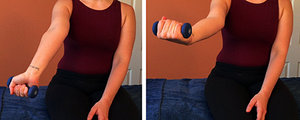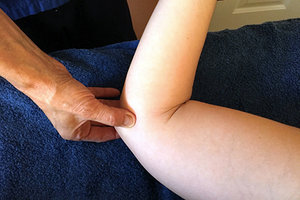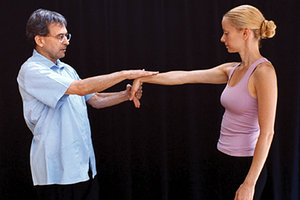The term golfer's elbow is a bit misleading because golfers are only a small segment of the population that suffers from this injury. The muscle-tendon unit involved in this injury is the flexor carpi radialis, the structure used to flex the wrist.
To locate the structures affected in golfer's elbow, press one of your elbows into the side of your body, squeezing it against your ribs as hard as you can. The bony protrusion pressing into your ribs is the medial epicondyle. Golfer's elbow usually occurs right at the medial epicondyle – specifically, at the tenoperiosteal junction of the flexor carpi radialis tendon (the portion of the tendon that is attached to the periosteum, or bone covering, of the medial epicondyle).
 This is the area of the muscle-tendon unit where the most stress and tension are exerted. If the structure is not rested after an initial strain, the injury may spread to affect the body of the tendon, the muscle belly, or at the distal attachment on the anterior side of the base of the second and third metacarpal bones of the hand. This spreading of the injury occurs if the structure is not rested or treated, and worsens over time.
This is the area of the muscle-tendon unit where the most stress and tension are exerted. If the structure is not rested after an initial strain, the injury may spread to affect the body of the tendon, the muscle belly, or at the distal attachment on the anterior side of the base of the second and third metacarpal bones of the hand. This spreading of the injury occurs if the structure is not rested or treated, and worsens over time.
How and Why This Injury Occurs
It's often hard for patients to remember what they did that brought on golfer's elbow. It can be caused by almost any activity that uses a repeated forehand motion – for example, intensive writing or typing, hammering, lifting, painting or overdoing wrist curls at the gym – and the pain often starts up to several days after the strain occurs. Often no pain is felt if the person is warmed up and involved in athletic activity such as golf or tennis.
Golfer's elbow can last a week, a month, or a year or two, depending on how well or poorly the strained fibers heal. If the person keeps repeating the activity that caused the strain, adhesive scar tissue may form and prolong the healing time. If the patient cannot or does not stop the pain-causing activities, the treatment will take much longer.
Referred pain is minimal in the elbow, but if the injury worsens, the person may experience the pain as radiating from the elbow toward the wrist. In that case, what's actually happening is that the injury is spreading throughout the muscle-tendon unit. Once the tenoperiosteal junction is injured, the whole structure is weakened and more vulnerable to injury.
If it is repeatedly put under stress, more and more fibers become strained. As a result, an injury that started at the tendon attachment soon spreads to the tendon body and then the muscle, as it tries in vain to do its work.
Increasingly in our society, people are working longer hours, exercising less, and spending more time on their computers for fun after work is over. This causes great strain on the flexor carpi radialis muscle-tendon unit. Whenever people don't exercise to gain and maintain flexibility and strength beyond what they need for their normal daily activities, things can break down quickly.
I recently began treating a woman with golfer's elbow who spends most of her day working at a computer, and who hasn't exercised for four years because she is so busy. Her good arm could lift a 2-pound weight just 20 times before tiring. Her injured arm could not lift even 1 pound without discomfort. The flexibility of both wrists was limited to 75 degrees. (A healthy wrist easily moves to 90 degrees of extension and flexion.)
This is a case of an injury that was just waiting to happen. Our goal now is to build up flexibility and enough strength in her flexors and extensors that she can easily exercise with 10 pounds with her good arm, and eventually (after six to eight weeks of treatment) with her injured arm as well.
Assessment: Resisted Flexion of the Wrist
 Resisted Flexion of the Wrist
Ask the patient to hold the injured arm out in front of the body and flex the hand down toward the floor. Place one of your hands on top of the wrist to support it, and wrap the fingers of your other hand around the palm. Next, ask the patient to hold the hand in this position while you try to pull it forward and up. Hold this isometric position for a few seconds. In a person with golfer's elbow, this action will cause pain at the medial elbow and/or into the forearm.
Resisted Flexion of the Wrist
Ask the patient to hold the injured arm out in front of the body and flex the hand down toward the floor. Place one of your hands on top of the wrist to support it, and wrap the fingers of your other hand around the palm. Next, ask the patient to hold the hand in this position while you try to pull it forward and up. Hold this isometric position for a few seconds. In a person with golfer's elbow, this action will cause pain at the medial elbow and/or into the forearm.
Treatment: Friction & Exercise Therapy
A combination of these two treatments is generally extremely effective within four to six weeks. The muscle-tendon unit is easily accessible.
 Friction Therapy
Friction: To perform the friction, it's best to have the patient's elbow bent at a 90-degree angle and the forearm slightly supinated. Place the tip of your thumb at the edge of the flexor carpi radialis tendon, just inferior to and up against the edge of the medial epicondyle; this is the tenoperiosteal junction. Press down to compress the tendon and friction in a medial direction.
Friction Therapy
Friction: To perform the friction, it's best to have the patient's elbow bent at a 90-degree angle and the forearm slightly supinated. Place the tip of your thumb at the edge of the flexor carpi radialis tendon, just inferior to and up against the edge of the medial epicondyle; this is the tenoperiosteal junction. Press down to compress the tendon and friction in a medial direction.
Continue for 5-6 minutes, take a break and repeat for a total of 10 to 12 minutes of frictioning. Then massage the upper arm and forearm to maximize blood circulation to the tendon.
An important caution when working in this area: The flexor carpi radialis is located right near the ulnar nerve. If your patient feels tingling or electric sensations down the arm, that means you've hit the nerve and you need to shift where you're working.
 Exercise Therapy
Exercise: Instruct patient to extend the injured arm in front of them, with the palm facing the ceiling, and use their other hand to support the elbow. Then, holding a 1- or 2-pound weight, patient should curl the hand up in flexion and then slowly lower it to the starting position. They should do three sets of 10 repetitions of this exercise, resting for a moment between sets.
Exercise Therapy
Exercise: Instruct patient to extend the injured arm in front of them, with the palm facing the ceiling, and use their other hand to support the elbow. Then, holding a 1- or 2-pound weight, patient should curl the hand up in flexion and then slowly lower it to the starting position. They should do three sets of 10 repetitions of this exercise, resting for a moment between sets.
Golfer's elbow is an extremely common condition for golfers and non-golfers alike. With more and more people working on computers or playing computer games for long periods of time, it will likely become even more prevalent over time. In treating golfer's elbow, friction therapy to reduce and eliminate the adhesive scar tissue, coupled with exercises to increase the flexibility and strength of the flexor carpi radialis, has proved to be extremely effective.
No matter what treatment is given, the person should be sure to limit activities, especially those that cause pain, until completely well. It is often tempting for patients to resume activities as soon as they begin to feel better; it's easy to lose perspective and resume exercise or work at a level that the body is not yet ready for. A slow, careful build-up of strength and flexibility is the most prudent course of action to ensure a full recovery and minimize the risk for re-injury.
Dr. Ben E. Benjamin holds a doctorate in education and sports medicine, and is the founder of the Muscular Therapy Institute. He resides in Cambridge, Mass., and can be reached with questions or comments regarding this article at
.




